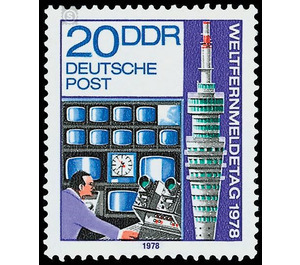World Telecommunication Day - Germany / German Democratic Republic 1978 - 20 Pfennig
Theme: Communication & Media
| Country | Germany / German Democratic Republic |
| Issue Date | 1978 |
| Face Value | 20.00 |
| Color | multi-colored |
| Perforation | K 14 |
| Printing Type | Rotogravure 2 |
| Stamp Type | Postage stamp |
| Item Type | Stamp |
| Chronological Issue Number | 2059 |
| Chronological Chapter | GER-DDR |
| SID | 139852 |
| In 19 Wishlists | |
World Telecommunication Day 1978 On the occasion of World Telecommunication Day 1978, the Ministry of Posts and Telecommunications of the German Democratic Republic publishes two multicolored special postage stamps. Special cancellation from April 25 to June 24, 1978 World Radio Day 1978 On May 17, the founding day of the International Telecommunication Union, the World Telecommunication Day is celebrated annually. It is each dedicated to a special motto, which takes into account the goals and tasks of the association as a special organization of the UNO. For 1978, the International Telecommunication Union has proposed to the member countries to commit the World Telecommunication Day under the motto "radio communication". This reflects the paramount role of radio in the development of telecommunications, whether in the creation of global telecommunications links, as a pre-requisite for maritime and air transport or in the development and enhancement of telecommunications facilities in developing countries. Radio and television have become indispensable in our lives today, and without wireless connections, the development of space by humans would not be possible. The motifs of the special postage stamps show on the 20-pfennig value Richtfunkleitzentrale and Fernsehturmkopf with lookout restaurant. The radio links are used to supply the radio and television programs to the transmitting stations of the network in high quality, but increasingly also the construction of telephone connections large transmission capacity. Direct television broadcasts from all areas of the Republic are made possible by transmitting the broadcast car's broadcast to the television broadcasting center via the nearest microwave radio station. The control and monitoring of the largely automatically operated microwave network is done by a few radio control centers. In representative towers of the television stations in some cases, scenic restaurants are located, which are attractive attractions for the population and tourist traffic.


